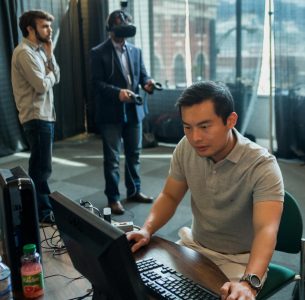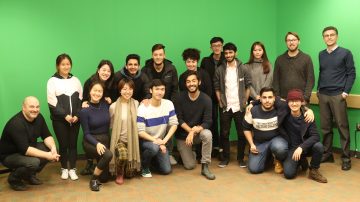Written by Samantha Peng
Mar. 6, 2019
If you have ever dreamt of starting a career or hobby in creating virtual reality experiences, take some tips from EML’s industry consultant, Peter Kao.
Peter Kao, CEO and co-founder of the Vancouver-based VR company Metanaut, has helped to shape and grow the Emerging Media Lab at UBC since its conception.
He mentors countless EML members, providing technical support, leadership guidance, and expert advice. Here are some of his tips to start working on VR projects.
1. Figure out what part of VR interests you.
“There are only so many things in the world where there’s a perfect balance between the creative side and the programming side, and that’s exactly what VR is.”
A project requires an artist or designer to create the visual elements of a VR world. But the project also needs a programmer to help the VR world to come to life, says Peter.
Students from all disciplines and different skills can find their place in a VR developing team.
2. Develop your soft skills.
Learn how to work with different types of people. According to Peter, artists and programmers don’t always see eye-to-eye in the creation of a project.
“But I think it’s always really important to know that compelling experiences, and this applies outside of VR too, involves a group of multidisciplinary people.”
The better you’re able to understand and communicate with people of other disciplines, the better you’ll be able to fit into impressive teams that will end up doing great things.
3. Do a ton of tutorials.
“I know some tutorials are incredibly boring, but I can promise you that doing any sort of tutorial involving VR is a lot of fun.”
If you’re interested in learning VR development, Peter recommends doing Unity tutorials which you can find on their website.
Unity is a game engine that is used by game developers all over the world. Half of all games are built on Unity with the majority of VR games being built with Unity.
“And that’s all you need to get started really.”
If you’re interested in the visual arts side of VR projects, Peter recommends doing tutorials for 3D modelling tools like Blender or Maya to create the models that will live inside your VR experience.
Bonus tip: “If you’re interested in the art side of things but you also have a passion for programming, look into writing Shader code.”
Shader code helps to create visual effects that are interesting and unique while being performant. According to Peter, “Shaders are becoming more and more important for the art development side of VR projects.”
If you need help learning how to use new software or tools, check out EML’s workshops.
4. Get involved with the Emerging Media Lab.
“EML Is the perfect place to get started in VR.”
The Emerging Media Lab has the resources and expertise to help you develop skills for VR as an organization that has been creating VR experiences on campus for the last three years.
As a member, you also get access to industry experts, like Peter, and the opportunity to work with talented students on campus.
And if you’re serious about a career in VR, you’ll be able to learn how to start and finish a project using industry standard methods.
“By joining EML, you’re showing to your future employers that you’re [familiar with industry tools and frameworks] and you know how to work with team members from different disciplines. You know all of this because you’ve worked on VR/AR projects before at EML.”
5. Know when to ask for help.
“I think the most successful students tend to be those who are, of course, passionate about their work, but they also seek the right kinds of help from the right kinds of people.”
Take a step back from the daily development, look at the big picture of your project, and figure out what problems may be upcoming. Then ask someone appropriate for help.
“Ask how to approach a certain type of problem and find help before you actually need it. Because that ends up saving a lot of time.”
EML and its experts can guide you in the right direction from the beginning before you commit to a certain direction that may not work out in the end.
The real tip? Just jump right into it!
The best way to learn new skills is to just get started. If you have any questions or want to get involved at the Emerging Media Lab, you can check out our website, visit our drop-in’s, or send us an email at emergingmedia.lab@ubc.ca.
If you’re curious about what it takes to be or what to expect as a member of the Emerging Media Lab, check out next week’s article: 10 things you want to know as an EML member.

Peter Kao working on a computer while two people in the background view a VR project.

The EML team at the end of November 2018.